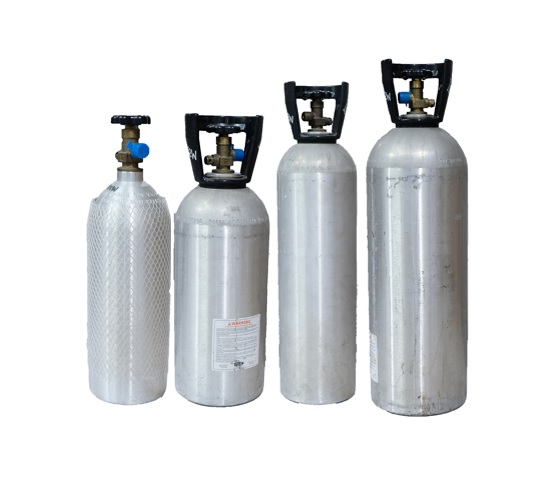Difference between revisions of "CO2 Cylinder Tank"
m |
|||
| Line 1: | Line 1: | ||
| − | CO2 tanks come in a range of CO2 cylinder sizes and volumes; from a basic 5lb co2 tank all the way up to a large 50lb co2 tanks. | + | CO2 tanks come in a range of CO2 cylinder sizes and volumes; from a basic 5lb co2 tank all the way up to a large 50lb co2 tanks. They are designed to contain CO2, a colorless but not odorless gas, consisting of one part carbon and two parts oxygen. At ordinary temperatures, carbon dioxide is relatively unreactive; above 1,700 °C (3,100 °F), it partially decomposes into carbon monoxide and oxygen. Unlike most standard gases, the content of a CO2 cylinder is in a liquid form because, just like propane, it is liquefied under pressure. These tanks should always be stored or used in the upright position. |
| + | |||
| + | *CO2 cylinder pressure is approx. 860 psi. | ||
| + | |||
| + | |||
[[File:Co2-Tank-imagefromsleezysourcesowhat.jpg]] | [[File:Co2-Tank-imagefromsleezysourcesowhat.jpg]] | ||
As compared to other types of tanks, specifically, for example, a propane tank: CO2 cylinders have much thicker walls than propane cylinders. Propane cylinders are 250 p.s.i. max pressure, CO2 cylinders are normally 1800 p.s.i. At 100 degrees F. propane exerts about 170 p.s.i., while CO2 exerts about 1400 p.s.i. Even at room temperature a full CO2 cylinders runs about 850 p.s.i. | As compared to other types of tanks, specifically, for example, a propane tank: CO2 cylinders have much thicker walls than propane cylinders. Propane cylinders are 250 p.s.i. max pressure, CO2 cylinders are normally 1800 p.s.i. At 100 degrees F. propane exerts about 170 p.s.i., while CO2 exerts about 1400 p.s.i. Even at room temperature a full CO2 cylinders runs about 850 p.s.i. | ||
| + | |||
| + | [[Category:Restaurant]] | ||
| + | [[Category:Tavern]] | ||
| + | [[Category:Science]] | ||
Revision as of 11:05, 11 February 2024
CO2 tanks come in a range of CO2 cylinder sizes and volumes; from a basic 5lb co2 tank all the way up to a large 50lb co2 tanks. They are designed to contain CO2, a colorless but not odorless gas, consisting of one part carbon and two parts oxygen. At ordinary temperatures, carbon dioxide is relatively unreactive; above 1,700 °C (3,100 °F), it partially decomposes into carbon monoxide and oxygen. Unlike most standard gases, the content of a CO2 cylinder is in a liquid form because, just like propane, it is liquefied under pressure. These tanks should always be stored or used in the upright position.
- CO2 cylinder pressure is approx. 860 psi.
As compared to other types of tanks, specifically, for example, a propane tank: CO2 cylinders have much thicker walls than propane cylinders. Propane cylinders are 250 p.s.i. max pressure, CO2 cylinders are normally 1800 p.s.i. At 100 degrees F. propane exerts about 170 p.s.i., while CO2 exerts about 1400 p.s.i. Even at room temperature a full CO2 cylinders runs about 850 p.s.i.
